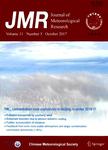Latitude-Dependent Response of East Asian Summer Monsoon to External Forcing in the Last Millennium
Latitude-Dependent Response of East Asian Summer Monsoon to External Forcing in the Last Millennium作者机构:School of Atmospheric SciencesNanjing University of Information Science & Technology State Key Laboratory of Lake Science and EnvironmentNanjing Institute of Geography and LimnologyChinese Academy of Sciences
出 版 物:《Acta meteorologica Sinica》 (Acta Meteorol. Sin.)
年 卷 期:2010年第24卷第6期
页 面:671-679页
核心收录:
学科分类:07[理学] 070601[理学-气象学] 0706[理学-大气科学]
基 金:Supported by the National Basic Research Program of China under Grant Nos.2010CB950102,2010CB833404,and 2011CB403301 the Innovation Project of Chinese Academy of Sciences under Grant Nos.KZCX2-YW-337 and NIGLAS2010XK02 the National Natural Science Foundation of China under Grant Nos.40871007,40890054,and 40672210
主 题:East Asian summer monsoon(EASM) external forcing precipitation millennium
摘 要:Response of the East Asian summer monsoon(EASM) rainfall to external forcing(insolation,volcanic aerosol,and greenhouse gases) is investigated by analysis of a millennium simulation with the coupled climate model *** model reproduces reasonably realistic present-day EASM *** simulated precipitation variation in East Asia over the last millennium compares favorably with the observed and proxy *** is found that the features and sensitivity of the forced response depend on *** the centennial-millennial time scale(CMTS),the extratropical precipitation closely follows the variation of the effective radiative forcing(insolation plus radiative effects of volcanic aerosols).The subtropical precipitation is less sensitive but the differences of this variable between the Medieval Warm Period(MWP) and Little Ice Age(LIA) remain *** tropical rainfall is insensitive to the external *** is also found that the precipitation variations in the extratropics and subtropics are in phase on the CMTS,while they are anti-correlated on the interannual time *** intertropical convergence zone(ITCZ) and subtropical precipitation are anti-correlated on the CMTS,so are they on the interannual time *** findings suggest that the proxy data in the extratropical East Asia more sensitively reflect the EASM variations,and this has important implications on interpretation of paleo-proxy records.




